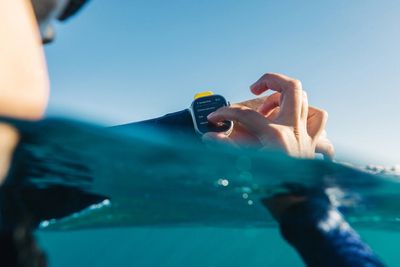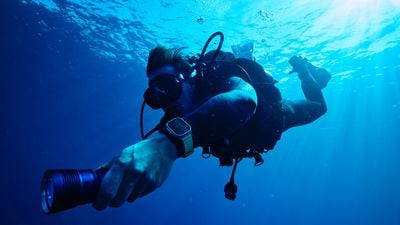Ahead of the Oceanic+ app launching on the Apple Watch Ultra today, a few individuals received some early hands-on time with a beta version of the app. Designed by Huish Outdoors in collaboration with Apple, the app allows the Apple Watch Ultra to be used as a dive computer for recreational scuba diving at depths up to 40 meters/130 feet.

For those unaware, rising to the surface level too quickly after scuba diving can result in decompression sickness, which occurs when dissolved gases like nitrogen in the blood and tissues form bubbles inside the body due to rapid depressurization. A dive computer aims to prevent decompression sickness by measuring the depth and elapsed time during a dive and using an algorithm to warn you if you are ascending too fast.
Apple Watch Ultra uses the Bühlmann decompression algorithm, which is said to be widely used and trusted across the scuba diving industry.
TechCrunch's Haje Jan Kamps believes the Apple Watch Ultra offers a "significantly nicer" user experience than traditional dive watches:
The Apple Watch Ultra's huge touch-screen makes the user experience significantly nicer than on traditional dive watches, which can be pretty indecipherable from time to time. Think user interfaces that seem like relics from the 1980s Casio watch era, and you get a pretty good idea.
Jan Kamps praised the app's color-coded safety warnings for no-decompression limit, excessive ascent rates, safety stop guidance, and water temperature, and noted that the haptic feedback for alerts is "easily felt through a wetsuit."
All in all, Jan Kamps was impressed with the Apple Watch Ultra and said it compared excellently to his dive watch from Finnish company Suunto:
Once in the water, there is remarkably little to say about the Apple Watch Ultra as a dive computer: It's easy to use; the crown and buttons are phenomenal as far as user interfaces go, the screens are well-designed; and the important information is clear and very easy to read.
I brought my trusty old Suunto that has been with me on many a dive to serve as my secondary dive computer for these test dives. The readouts from the two dive computers were almost identical all the way through. The small differences can be attributed to having the Suunto in my pocket while the Apple Watch was on my wrist.
Jan Kamps did note that two out of around 40 divers he tested Oceanic+ with experienced unspecified issues with the app, but he was not entirely sure if this was the result of user error or whether the app malfunctioned in some way.

Priced at $799, the Apple Watch Ultra features new depth gauge and water temperature sensors that allow Oceanic+ to function. On a "cost-per-day-used basis," Jan Kamps argued that the Apple Watch Ultra is an "absolute bargain compared to every dive computer on the market today" since it can also be used for other smartwatch functions.
Conversely, CNET's Jesse Orrall said the Apple Watch Ultra being a smartwatch rather than a dedicated dive computer "sometimes made it difficult" to use. Specifically, he said most dive computers "don't have a touchscreen or a water lock, and they don't require a passcode," but it's worth noting that the Oceanic+ website says as soon as the Apple Watch Ultra enters the water, it works even without a passcode for diving.
Orrall said scrolling through the Oceanic+ screens with the Digital Crown can be tricky:
Scrolling through the various screens with the digital crown was doable in gloves, but I accidentally scrolled past the screen I wanted a few times. I wish I could use the Apple Watch Ultra's physical side buttons to "press and hold" and toggle through the different dive screens.
DC Rainmaker's Ray Maker agreed:
About the only complaint I'd have was that the digital crown underwater seemed a bit finicky in terms of over-spinning the data pages. Getting it exactly the page I want was sometimes tricky. I'd imagine with gloves it'd be messier. It's almost like the sensitivity was…well…too sensitive. But that's a minor nit overall.
Both Orrall and Maker also pointed out that the Apple Watch Ultra cannot show how much air is remaining in a tank like some dive computers can.
Overall, Maker was impressed with the app:
As for the Oceanic+ app, it's a solid starting point, especially for casual divers. It includes everything pretty much any casual diver would need, and does it in a silly easy to use fashion. I mean, you literally just drop in the water and the app automatically starts. You don't even need to press anything to use the app. During the dive, it dutifully let me know when it was time to head up, as well as would have alerted me had I ascended to fast. It also kept track of my safety stop and reminded me of that as I passed up through that depth.
Maker said the Apple Watch Ultra's depth tracking was virtually lockstep with the Garmin Descent G1 dive computer in an indoor diving facility.
Oceanic+'s basic plan for snorkelling is free and includes depth, time, and a log of most recent dives. For $4.99 per day, $9.99 per month, or $79.99 per year, more experienced scuba divers can get access to decompression tracking, tissue loading, unlimited logbook capacity, and other stats for deeper dives. Maker said this pricing is "fairly reasonable," especially for casual divers who already own an Apple Watch Ultra.
Oceanic+ is available on the App Store and requires an Apple Watch Ultra running watchOS 9.1 or later paired with an iPhone 8 or later running iOS 16.1 or later. A companion iPhone app serves as a digital logbook for dives with detailed post-dive summaries.
Apple says users should always follow diving protocols, dive with a companion, and have a secondary device for tracking depth and time.
Scuba Diver Magazine's Mark Evans also reviewed the Oceanic+ app.
























